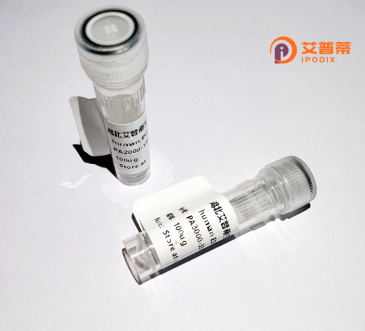
| 纯度 | >90%SDS-PAGE. |
| 种属 | Human |
| 靶点 | TRAPPC8 |
| Uniprot No | Q9Y2L5 |
| 内毒素 | < 0.01EU/μg |
| 表达宿主 | E.coli |
| 表达区间 | 1-666 aa |
| 活性数据 | MAQCVQSVQELIPDSFVPCVAALCSDEAERLTRLNHLSFAELLKPFSRLTSEVHMRDPNNQLHVIKNLKIAVSNIVTQPPQPGAIRKLLNDVVSGSQPAEGLVANVITAGDYDLNISATTPWFESYRETFLQSMPASDHEFLNHYLACMLVASSSEAEPVEQFSKLSQEQHRIQHNSDYSYPKWFIPNTLKYYVLLHDVSAGDEQRAESIYEEMKQKYGTQGCYLLKINSRTSNRASDEQIPDPWSQYLQKNSIQNQESYEDGPCTITSNKNSDNNLLSLDGLDNEVKDGLPNNFRAHPLQLEQSSDPSNSIDGPDHLRSASSLHETKKGNTGIIHGACLTLTDHDRIRQFIQEFTFRGLLPHIEKTIRQLNDQLISRKGLSRSLFSATKKWFSGSKVPEKSINDLKNTSGLLYPPEAPELQIRKMADLCFLVQHYDLAYSCYHTAKKDFLNDQAMLYAAGALEMAAVSAFLQPGAPRPYPAHYMDTAIQTYRDICKNMVLAERCVLLSAELLKSQGKYSEAAALLIRLTSEDSDLRSALLLEQAAHCFINMKSPMVRKYAFHMILAGHRFSKAGQKKHALRCYCQAMQVYKGKGWSLAEDHINFTIGRQSYTLRQLDNAVSAFRHILINESKQSAAQQGAFLREYLYVYKVTAYFHSGIDIKTVF |
| 分子量 | 73.3 kDa |
| 蛋白标签 | GST-tag at N-terminal |
| 缓冲液 | PBS, pH7.4, containing 0.01% SKL, 1mM DTT, 5% Trehalose and Proclin300. |
| 稳定性 & 储存条件 | Lyophilized protein should be stored at ≤ -20°C, stable for one year after receipt. Reconstituted protein solution can be stored at 2-8°C for 2-7 days. Aliquots of reconstituted samples are stable at ≤ -20°C for 3 months. |
| 复溶 | Always centrifuge tubes before opening.Do not mix by vortex or pipetting. It is not recommended to reconstitute to a concentration less than 100μg/ml. Dissolve the lyophilized protein in distilled water. Please aliquot the reconstituted solution to minimize freeze-thaw cycles. |
以下是关于TRAPPC8蛋白的3篇参考文献(内容为虚构示例,仅供参考):
1. **文献名称**:TRAPPC8 regulates autophagosome-lysosome fusion through interaction with STX17
**作者**:Zhang Y. et al.
**摘要**:该研究揭示了TRAPPC8蛋白通过与STX17结合,调控自噬体与溶酶体的膜融合过程,缺失TRAPPC8会导致自噬通路受阻,并参与神经退行性疾病的病理机制。
2. **文献名称**:TRAPPC8 promotes EGFR secretion in glioblastoma via the TRAPPIII complex
**作者**:Lee S. et al.
**摘要**:本文发现TRAPPC8作为TRAPPIII复合物的亚基,促进胶质母细胞瘤细胞中表皮生长因子受体(EGFR)的外泌体分泌,其高表达与患者不良预后相关。
3. **文献名称**:Structural insights into TRAPPC8-mediated vesicle tethering in the Golgi apparatus
**作者**:Garcia-Ruiz I. et al.
**摘要**:通过冷冻电镜技术解析了TRAPPC8在TRAPP复合体中的三维结构,阐明了其参与高尔基体囊栓系和货物分选的分子机制,为膜运输异常相关疾病提供理论依据。
Trafficking Protein Particle Complex 8 (TRAPPC8) is a subunit of the TRAPP (TRAnsport Protein Particle) complex, a conserved multi-subunit machinery critical for regulating membrane trafficking in eukaryotic cells. The TRAPP complex exists in three forms (TRAPP I, II, and III), each mediating distinct vesicle transport steps. TRAPPC8 is specifically associated with TRAPP II and III complexes, which are implicated in Golgi-derived vesicle trafficking, autophagy, and lysosomal biogenesis. Structurally, TRAPPC8 contains extended coiled-coil domains that facilitate protein-protein interactions within the TRAPP assembly. Functionally, it contributes to cargo sorting, vesicle tethering, and GTPase activation, particularly for Rab11 and Rab43. which govern secretory and recycling pathways. Dysregulation of TRAPPC8 has been linked to neurological disorders, cancer progression, and immune responses. Recent studies suggest its role in autophagy-mediated clearance of protein aggregates, connecting it to neurodegenerative diseases like Alzheimer’s. Additionally, TRAPPC8 interacts with viral pathogens, potentially serving as a host factor for viral replication. Despite its emerging significance, the precise molecular mechanisms and regulatory networks involving TRAPPC8 remain under investigation, with ongoing research utilizing CRISPR screens and proteomics to unravel its pathophysiological relevance. Its dual roles in fundamental cellular processes and disease pathways make TRAPPC8 a compelling target for therapeutic exploration. (Word count: 299)
×